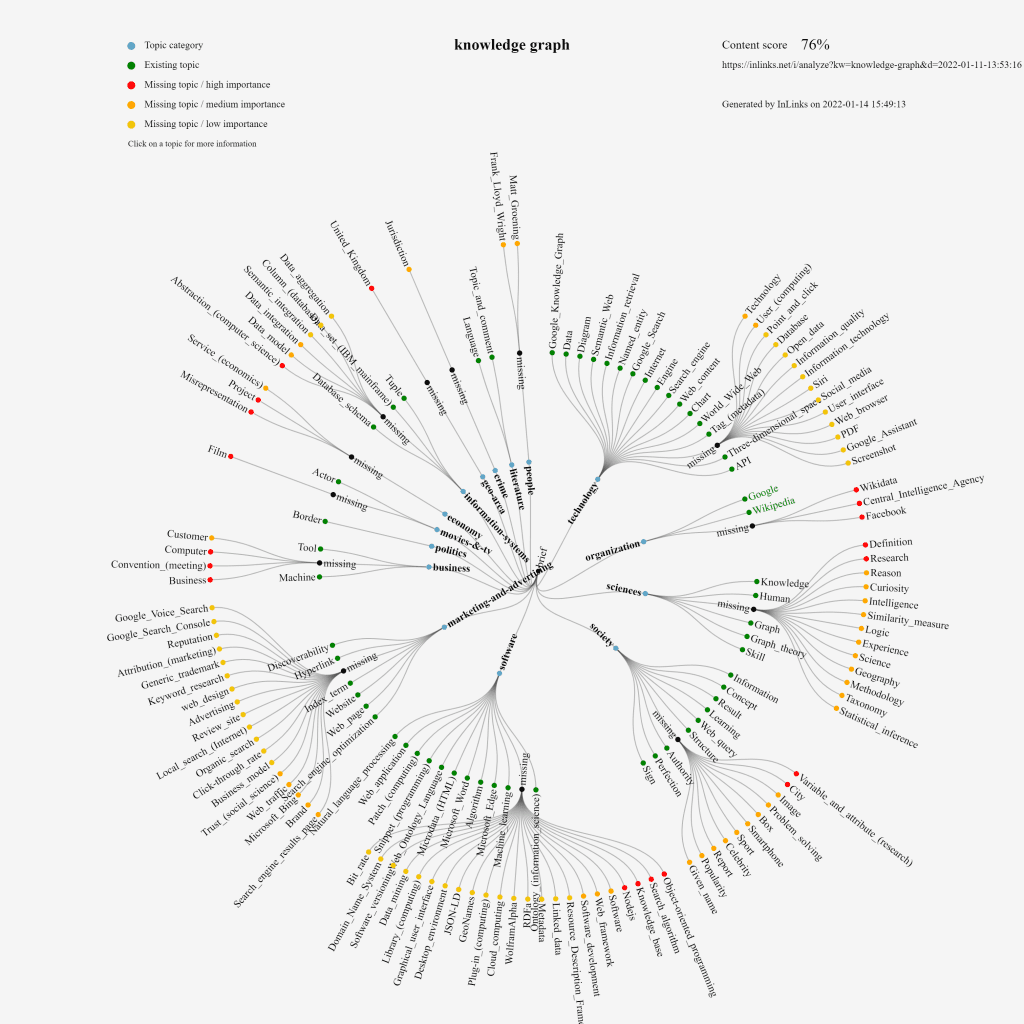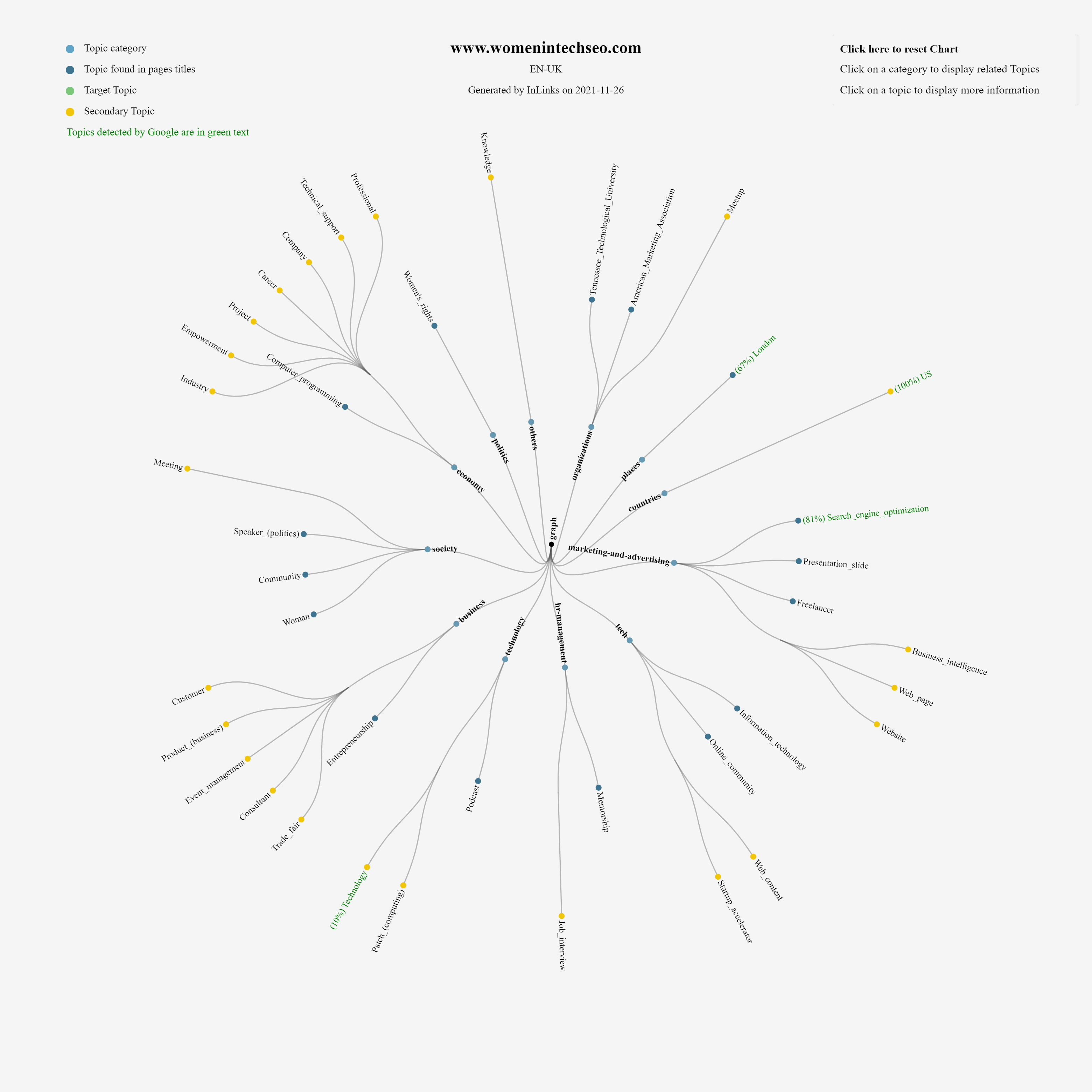What is a Knowledge Graph?
Simply put, a knowledge graph is a big mind map of connections. For example, if you start with a banana and brainstorm around it on a piece of paper, you may come up with a variety of concepts such as lunch, banana bread, trees, Fairtrade, yellow, slipping over, monkeys… the list is almost endless. If something as singular and simple as a banana has all these connections, just imagine how many connections there would be if you did this for everything in existence. Well, that’s exactly what a knowledge graph does. It takes internet data and ‘mind maps’ relationships, synonyms, connotations, and double meanings to provide the relevant information one may need to contextualize their starting point.
The History of Knowledge Graphs
The idea of a semantic web had been an aspiration from its inception. However, the actual concept of a knowledge graph was coined as early as 1972 in the academic literature by Edward W. Schneider. Later on, topic-specific knowledge graphs or ‘semantic networks’ began to take place, with organizations like Wordnet and Geonames. This then evolved into more general knowledge graphs which leveraged Wikipedia, such as DBpedia, and public databases, such as Freebase.
In 2012, Google announced the launch of its knowledge graph where it built on the work done by DBpedia and Freebase among other sources. This was a new way to return search results based on a natural language processing algorithm, that organizes big data to return the most semantically relevant answers. This incurred some monumental changes for SEO. And, from this point onwards keywords in isolation started to get left behind in strategic SEO. Instead, a more in-depth focus on semantically related packages of words that give a contextualized overview of what you are really started to come into play.
What can Knowledge Graphs Do?
Knowledge graphs really are very human, constantly using machine learning to evolve and engulf information. They are made up of triples. These are two entities, maybe a banana and a tree, and a connection that uses language tags from schema.org to signify their relation. Many triples together create complex knowledge graphs which allow for an intuitive and semantic web that mimics human understanding. In fact, theories of linguistic understanding come from Piaget’s theory of knowledge graphs and schemata, creating an overlapping Venn diagram between machine and human learning.
Rich Snippets and Knowledge Panels
Google’s knowledge graph has given birth to rich snippets and the knowledge panels which pop up with all relevant information relating to your initial search query. Here’s an example:

The triples are working together to give you the most relevant information based on semantic closeness and ai learning of what others before you have wanted to know. The more established an entity is, like if it has a Wikipedia page, the more information collected/connected in these snippets. Think of these as Google’s digital mind map, immediately making connections such as band members, music genres, streaming services, etc without you inputting this into your initial search query.
Knowledge graphs enable Google to not only understand the query better and offer the most relevant information- but also your content. It will use sentiment analysis to really grasp the topics and entities working together.
What is the Relationship Between Knowledge Graphs and Schema Markup?
Schema markup is basically a big red flashing sign crawlers get before they read your site which tells them exactly what they are about to read. It sets the topic of your site and the secondary mentions your site exhibits. Schema markups spell out the content of your website in very simple terms to help search engines know which page is most relevant. But without a knowledge graph behind the schema markup, the intelligence of about schema is significantly diminished already.
You have three options when writing content for the semantic web.
Let your knowledge graph content do the talking
You can opt to only create content that exhibits an excellent knowledge graph and then let google figure out what you are talking about. This does work but puts the onus on Google to really comprehend your words. Now, this leaves you with little room for knowledge graph-related errors! There are tools that will help you to curate quick schemata around your keywords to complete this.
Let your schema markup do the talking
There is little evidence to suggest that schema markup alone is a weighted factor in SEO. However, it is undoubtedly becoming synonymous with high-ranking content. By using SameAs, and mentions tags you will be able to tell Google what you are talking about, but you may not have the content to back this up.
Let your knowledge graph and schema markup work together
To have the most informative and accessible piece of content, I would recommend this option. Having an in-depth schema mark-up is essential for creating rich snippets, faq sections, and overall visibility at the top of the search engine. But if the content behind these markups just doesn’t fulfill the brief then Google will not see you as truly authoritative on the topic you’re talking about. Updating your strategy to include an awareness of knowledge graphs and an in-depth schema markup is a surprisingly rare but effective strategy.
Don’t just take my word for it. You can view a variety of case studies that have implemented both of these strategies with great success over at Inlinks.
What Does This Mean For SEO?
With such smart ways of interpreting data, you must be clued up on the words which trigger and fulfill a rich knowledge graph around the entity you want to rank for. If you want to rank for bananas, you better make sure you understand how Google conceptualizes a banana, along with relevant and unique information which fulfills the search query.
It is not about keyword density/stuffing. In fact, search engines condemn this practice. It is rather about how you use semantically related topics together to offer the most useful information based on Google’s assumptions. I like to think of semantic SEO as creating the perfect potion. In this metaphor, key terms are the ingredients used together to cook up the most potent dose of information. You will want to be sparing with your ingredients to save time and money, but there is still room in this potion recipe for you to get creative and make it unique. This is magic after all 🙂
You cannot exist on the internet in keyword isolation, because Google is constantly looking for the full package, according to the connections it made on its knowledge graph. But googles knowledge graph is hidden, so how do we know what words really do trigger these connections and make the perfect SEO potion?
Well, one solution is to make your own knowledge graph. This is not an easy task but using language from schema.org is a viable option to some people. Once you know what you want to rank for creating your own knowledge graph can reveal the path that google will be following to see if your content is helpful enough to rank highly.
Inlinks Optimization
Inlinks optimization has built its own knowledge graph using authoritative data sets, such as Wikipedia. It has hundreds of thousands of interconnected data points to help you write your content in a conducive and optimized fashion. With this knowledge graph you can expect to optimize your data by using the terms that google likes and get real-time updates on how semantically strong and interconnected your content really is as you write it.
For example, here I created the Knowledge Graph for the key term ‘knowledge graph’… Knowledge graph inception!

This allows me to see the topics and entities that others are using in their content regarding knowledge graphs. It presents missing topics as weighted entities, with red phrases like ‘knowledge base’ labeled as important additions. It also categorizes these entities into manageable sectors: sciences, society, business, etc. This is to help you become well optimized for your niche.
Not only this, but it also generates and adds the complicated schema markup for you. It automates and applies schema markup according to topic authorities you label manually. FAQ schemas are also generated, which are heavily connected to the idea that no search is thought of in isolation.
You can start for free here. Create a content brief around a keyword that you want to rank for and leverage the Inlinks knowledge graph in your content strategy!





I love the Piaget link and the way you are explaining Knoweldeg Graphs. SEOs seem to forget that schema predated the web.
Exactly! the comparison can get a bit confusing as when Piaget talks about schemata he is really talking about something that resembles a knowledge graph. But it’s interesting that schema in a web context evolved to mean something else, and that KGs took schema’s place as the building blocks of understanding.
Leave a Reply
Want to join the discussion?Feel free to contribute!